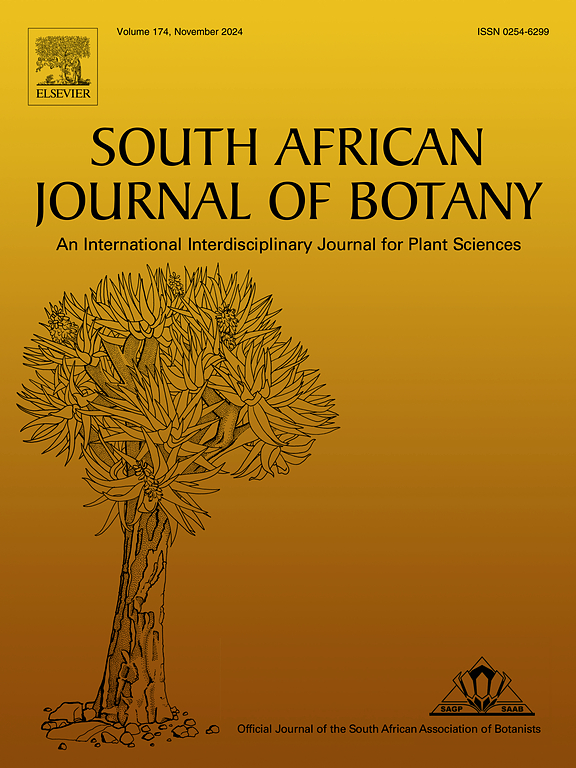Anti-cancer effects of Plumbago zeylanica L. against human triple-negative breast cancer: Insights from network pharmacology and in-vitro experimental validation
IF 2.7
3区 生物学
Q2 PLANT SCIENCES
引用次数: 0
Abstract
Triple-negative breast cancer (TNBC) is an aggressive subtype of breast cancer that lacks targeted therapeutic options due to the absence of estrogen, progesterone and HER2 receptors. The present study explores the anti-cancer potential of Plumbago zeylanica L. (P. zeylanica), a medicinal plant known for its diverse pharmacological properties. Using a combined approach of network pharmacology and in-vitro experimental validation, present study investigates the bioactive compounds in P. zeylanica and their interactions with molecular targets involved in TNBC progression. Network pharmacology identified 380 potential targets of P. zeylanica and 2890 TNBC-associated targets, intersecting to reveal 129 common targets. Gene enrichment and pathway analyses highlighted key pathways, including EGFR resistance, HIF-1 signaling and breast cancer pathways. Molecular docking and molecular dynamics (MD) simulations further supported these findings, revealing strong binding affinities between P. zeylanica compounds, particularly zeylanone and critical proteins like PARP1, ESR1 and HSP90AA1. In-vitro assays on MDA-MB-231 cells showed a dose- and time-dependent reduction in cell viability, with an IC50 of 90.79 μg/mL. Apoptosis induction was confirmed through Annexin V/PI staining, with 23 % early apoptosis and 0.90 % late apoptosis. Furthermore, cell cycle analysis revealed G1 phase arrest, inhibiting cell proliferation. These results suggest that P. zeylanica is a promising natural therapeutic agent against TNBC, warranting further research for potential clinical applications in cancer treatment.

白花苜蓿对人三阴性乳腺癌的抗癌作用:网络药理学的见解和体外实验验证
三阴性乳腺癌(TNBC)是一种侵袭性乳腺癌亚型,由于缺乏雌激素、孕激素和HER2受体,缺乏靶向治疗选择。本研究探讨了以其多种药理特性而闻名的药用植物白花苜蓿(Plumbago zeylanica L.)的抗癌潜力。本研究采用网络药理学和体外实验验证相结合的方法,研究了白桦的生物活性化合物及其与TNBC进展中涉及的分子靶点的相互作用。网络药理学鉴定出380个潜在靶点和2890个tnbc相关靶点,共发现129个共同靶点。基因富集和通路分析强调了关键通路,包括EGFR耐药、HIF-1信号传导和乳腺癌通路。分子对接和分子动力学(MD)模拟进一步支持了这些发现,揭示了zeylanica化合物,特别是zeylanone与PARP1, ESR1和HSP90AA1等关键蛋白之间的强结合亲和力。MDA-MB-231细胞体外实验显示细胞活力呈剂量和时间依赖性降低,IC50为90.79 μg/mL。Annexin V/PI染色证实细胞凋亡诱导,早期凋亡23%,晚期凋亡0.90%。此外,细胞周期分析显示G1期阻滞,抑制细胞增殖。这些结果表明,白桦属植物是一种很有前景的天然治疗TNBC的药物,值得进一步研究,在癌症治疗中的潜在临床应用。
本文章由计算机程序翻译,如有差异,请以英文原文为准。
求助全文
约1分钟内获得全文
求助全文
来源期刊

South African Journal of Botany
生物-植物科学
CiteScore
5.20
自引率
9.70%
发文量
709
审稿时长
61 days
期刊介绍:
The South African Journal of Botany publishes original papers that deal with the classification, biodiversity, morphology, physiology, molecular biology, ecology, biotechnology, ethnobotany and other botanically related aspects of species that are of importance to southern Africa. Manuscripts dealing with significant new findings on other species of the world and general botanical principles will also be considered and are encouraged.
 求助内容:
求助内容: 应助结果提醒方式:
应助结果提醒方式:


